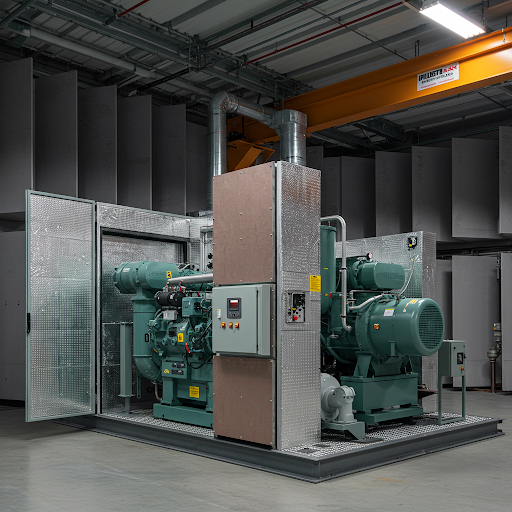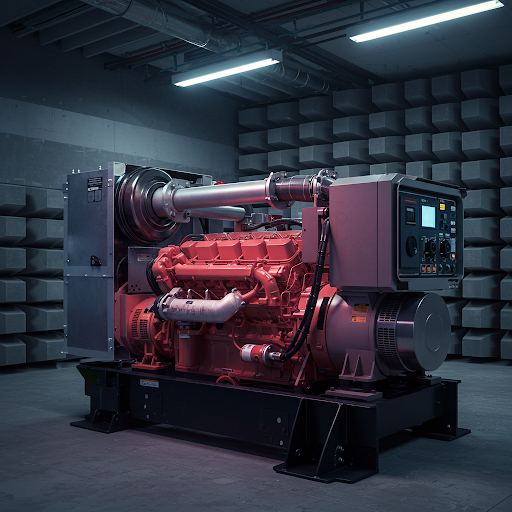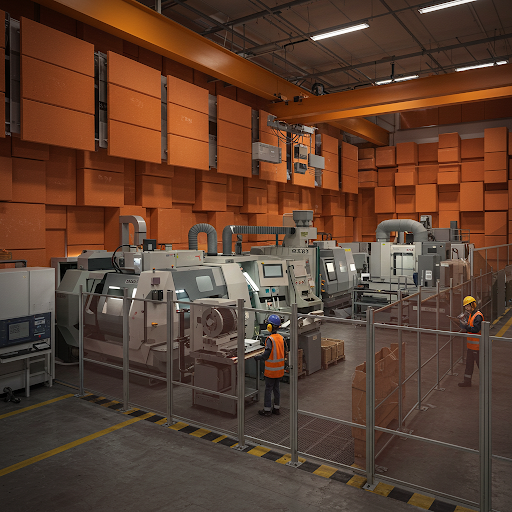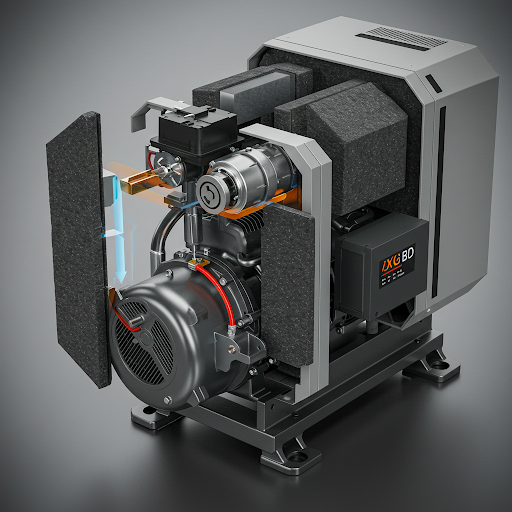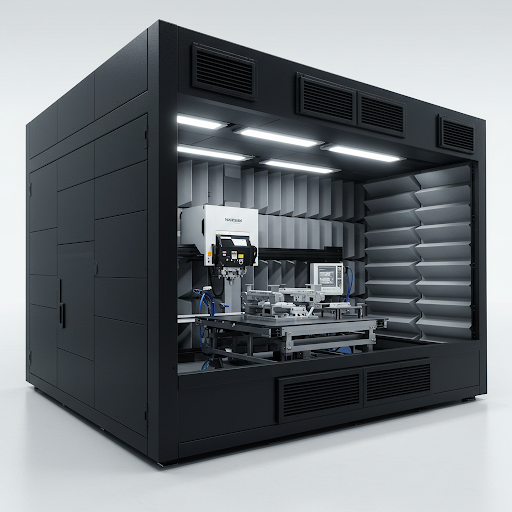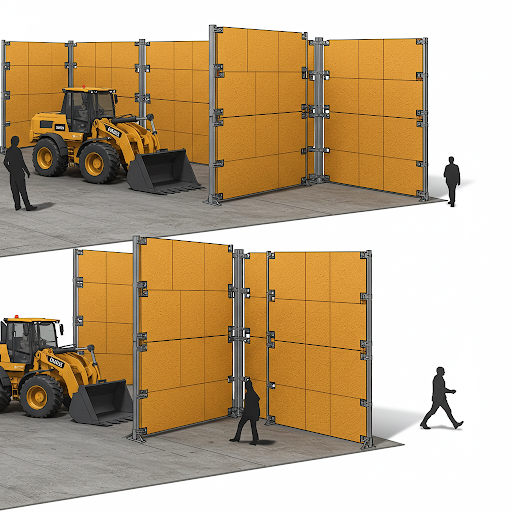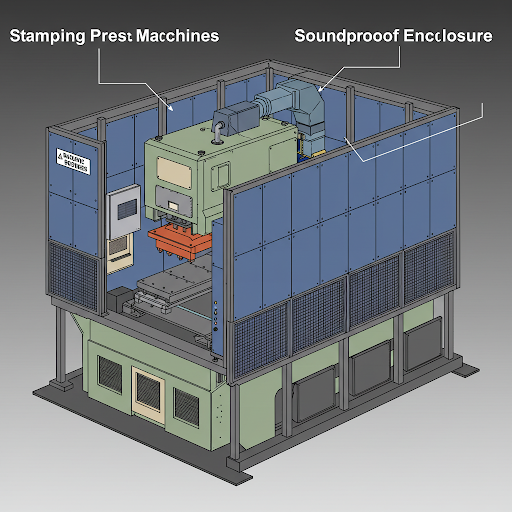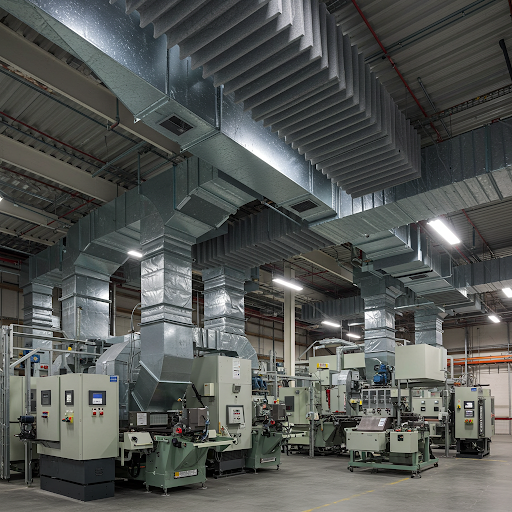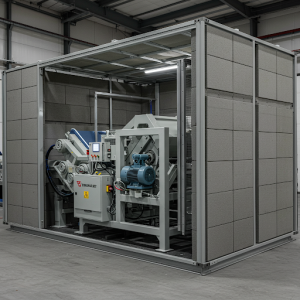Description
In Kenya, the soundproofing of industrial machines is primarily governed by the Environmental Management and Coordination Act (EMCA) of 1999 and the Noise and Excessive Vibration Pollution (Control) Regulations of 2009. These regulations establish permissible noise levels for industrial zones and mandate industries to implement measures to mitigate noise pollution.
The National Environment Management Authority (NEMA) is the key body responsible for enforcing these regulations, including issuing licenses for noise emissions exceeding permissible limits. County governments also play a role in local enforcement. Compliance is crucial for industries to avoid penalties and ensure a healthy environment for workers and surrounding communities.

Soundproofing industrial machines is paramount for several reasons. Firstly, it safeguards worker health by preventing noise-induced hearing loss and reducing stress levels, contributing to a safer work environment.
Secondly, it enhances productivity by minimizing distractions and improving communication among employees. Compliance with noise regulations is another critical aspect, helping businesses avoid potential fines and legal issues. Furthermore, soundproofing fosters better relationships with neighboring communities by reducing noise pollution. Ultimately, investing in industrial soundproofing creates a more comfortable, efficient, and legally sound operational environment.
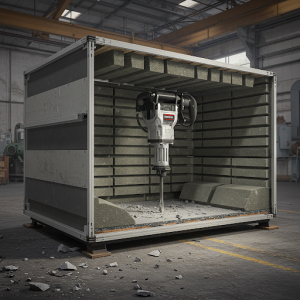
Common noisy industrial machines include compressors, generators, pumps, crushers, grinders, and various power tools like jackhammers and saws. Fans and ventilation systems also contribute significantly to noise.
The types of noise produced can be categorized as continuous (constant hum or whir), intermittent (cyclical or irregular), and impulsive (sudden impacts or explosions). Other classifications include airborne (traveling through air), structure-borne (vibrations through materials), and fluid-borne (through liquids or gases). The frequency can range from low-frequency hums to high-pitched squeals.
1. Enclosures for soundproofing industrial machines
2. Industrial Machines Sound-Absorbing Materials
3. Industrial Machines Vibration Isolation
Anti-Vibration Mounts and Pads

The Anti-Vibration Mounts and Pads are used to decouple machinery from the floor and surrounding structures, preventing vibrations from transmitting and radiating as noise. They are made from materials like rubber, neoprene, and springs.
Anti-vibration mounts and pads are crucial for minimizing the transmission of vibrations from industrial machines to the surrounding environment and supporting structures. These components, often made of rubber, elastomers, or specialized composites, act as a buffer, absorbing and dissipating mechanical energy.
Anti-vibration mounts are typically designed to attach directly to the machinery and the floor or supporting frame. They come in various types like bobbin mounts, conical mounts, and plate mounts, each suited for different load capacities and vibration frequencies.
Anti-vibration pads are flat layers of damping material placed under the machine’s feet. They are a simpler and often more cost-effective solution for lighter machinery or where direct mounting is not feasible. Both mounts and pads help reduce noise, protect equipment, extend lifespan, and improve workplace safety and comfort.
4. Industrial Machines Sound Damping Materials
Industrial machine sound-damping materials are crucial for reducing noise generated by vibrating surfaces and components. Unlike sound-absorbing materials that target airborne sound waves, damping materials focus on minimizing structural vibrations, which can radiate noise and cause fatigue in machinery.
Common types of sound-damping materials include viscoelastic polymers, constrained layer damping (CLD) materials, and spray-on damping compounds. Viscoelastic polymers are highly effective at converting vibrational energy into heat due to their internal friction. CLD involves a layer of viscoelastic material sandwiched between two rigid layers (often metal), enhancing damping performance across a broader frequency range. Spray-on damping compounds offer ease of application to complex surfaces and can provide significant noise reduction.
The selection of the appropriate damping material depends on factors such as the frequency and amplitude of vibration, the operating temperature of the machinery, and the desired level of noise reduction.
Proper application is essential for optimal performance, ensuring good adhesion and coverage of the vibrating surfaces. By reducing structural vibrations, damping materials contribute to a quieter, more stable, and longer-lasting industrial environment.
5. Silencers and Mufflers for Soundproofing Industrial Machines
Silencers and mufflers are essential devices for reducing noise generated by the intake and exhaust of industrial machinery, particularly those involving airflow or gas expulsion. They work by incorporating internal baffles, sound-absorbing materials, and expansion chambers that disrupt and dissipate sound waves as they pass through.
Silencers are commonly used for systems like ventilation fans and blowers, aiming to reduce broadband noise. Mufflers, often found on engines, compressors, and vacuum pumps, are specifically designed to attenuate the louder, often lower-frequency noise produced by pulsating gas flows. Proper selection and installation are critical for effective noise reduction without hindering the machine’s performance.
6. Equipment Redesign and Maintenance
Quieter Machinery Selection
When investing in new industrial equipment, actively seek out models with documented lower noise emission ratings. Comparing decibel levels and considering built-in noise reduction features can significantly impact the overall sound environment.
Regular Maintenance
Consistent maintenance is key to minimizing operational noise. Lubricating moving parts reduces friction and squealing, tightening loose bolts prevents rattling, and promptly replacing worn bearings or belts avoids excessive noise generation. Proactive maintenance ensures smoother, quieter operation and prolongs equipment lifespan.
7. Personal Protective Equipment (PPE)
Earplugs and Earmuffs

While not a soundproofing solution for the machinery itself, PPE is crucial for protecting workers’ hearing in noisy environments.
Should be used in conjunction with engineering controls (like enclosures and sound-absorbing materials) as a last line of defense.
Key Considerations for Soundproofing Industrial Machines
Noise Assessment
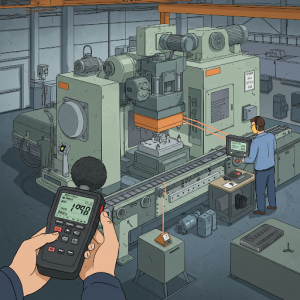
Accurate industrial machine noise level measurements are the foundation of effective soundproofing in Nairobi. Employ sound level meters to quantify noise emissions from each machine, identifying the loudest sources and the dominant frequencies produced.
This data is crucial for diagnosing the specific noise problems. And selecting the most appropriate and cost-effective noise reduction strategies, ensuring compliance with Kenyan regulations.
Frequency of Noise
Understanding the frequency of industrial machine noise is critical for effective soundproofing in Nairobi. Low-frequency noise (like machine rumble) requires dense, massive materials for blocking, while high-frequency noise (like squeals) is better absorbed by porous materials. Matching the soundproofing materials and techniques to the dominant noise frequencies ensures optimal noise reduction and cost-effectiveness in your Nairobi facility.
Budget
Implementing soundproofing solutions for industrial machinery involves a spectrum of costs. It’s crucial to align your budget with the most effective noise reduction strategies. Prioritize measures that offer the highest impact on noise levels for the investment, such as addressing the loudest sources or implementing fundamental techniques like enclosures or vibration isolation for key machines. A phased approach can also help manage expenses.
Integration with Operations
Soundproofing installations must be meticulously planned to allow unimpeded access for routine inspections, preventative and reactive maintenance, and all standard operational procedures. Removable panels, access doors, and strategically placed openings should be incorporated into the design. Materials and construction methods should not obstruct critical components or require extensive dismantling for servicing. Prioritizing accessibility ensures that noise reduction measures do not compromise the longevity, safety, or efficiency of the machinery. Regular checks and maintenance of the soundproofing itself are also essential to maintain its effectiveness.
Professional Consultation
Seeking expertise from Wallpaper Kenya’s acoustic engineers is invaluable. We can conduct thorough noise assessments, identify specific noise sources and pathways, and recommend tailored soundproofing solutions based on your machinery, facility layout, and budget. Sound engineers’ guidance ensures effective implementation of strategies like enclosure design, material selection, and vibration isolation, maximizing noise reduction and optimizing your investment for a quieter and more productive industrial environment in Nairobi or elsewhere in Kenya.

